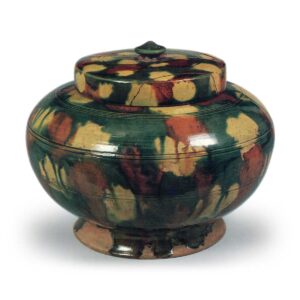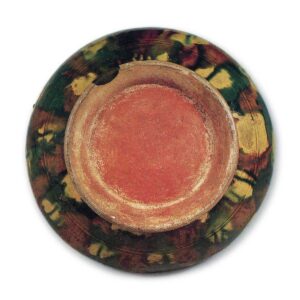

Sansai glazed ware: covered jar.
From Noborito, Kawasaki City, Kanagawa Prefecture
8th century
Total height 16.5cm, lid diameter 12.1cm, body diameter 10.3cm, body diameter 19.8cm, bottom diameter 12.9cm
Important Cultural Property
It is said to have contained cremated bones at the time, and is known to have been used as a warehouse cinerary urn. It is known to have been used as a warehouse urn, as it is said to have contained cremated bones at the time. The vividness of the glaze on this ware has given rise to the theory that it was faked, but since such warehouse urns are usually placed in a stone chest, it must have been extremely well preserved. This is one of the best examples of this type of Sansai vase, as it is correctly based on the techniques of the time in terms of the base, molding, glazing, and firing. The base is a slightly iron-reddish pink color, and is well fired with a four-tiered, double-chinked line running from the shoulder to the body. The body is almost spherical in shape, with the shoulder having lost its tension, and the shape of the neatly made bead-shaped knob on the lid suggests that it must have been made near the end of the Nara period. The technique of applying a yellowish-brown glaze to the intersections of a latticework of green ground with white spots scattered on different levels as dotted landscapes is common to all Sansai vases. The vermilion remains brightly adhered to the back of the base, and as with the other examples, there is a strong possibility that this jar was housed in a stone chest.



